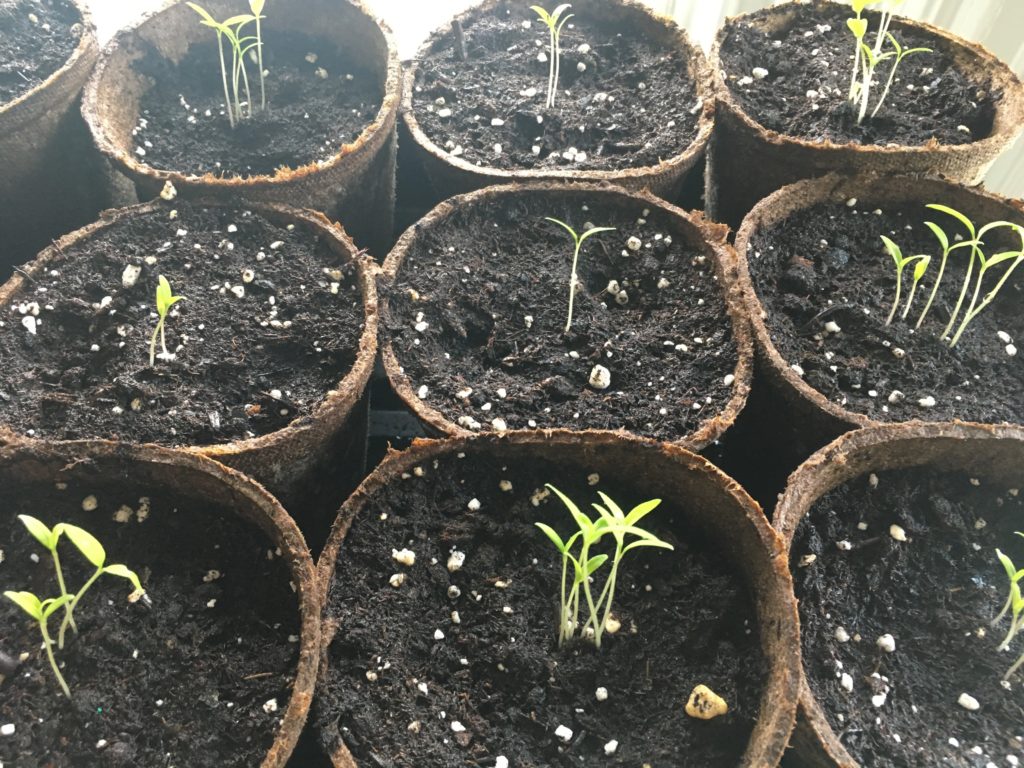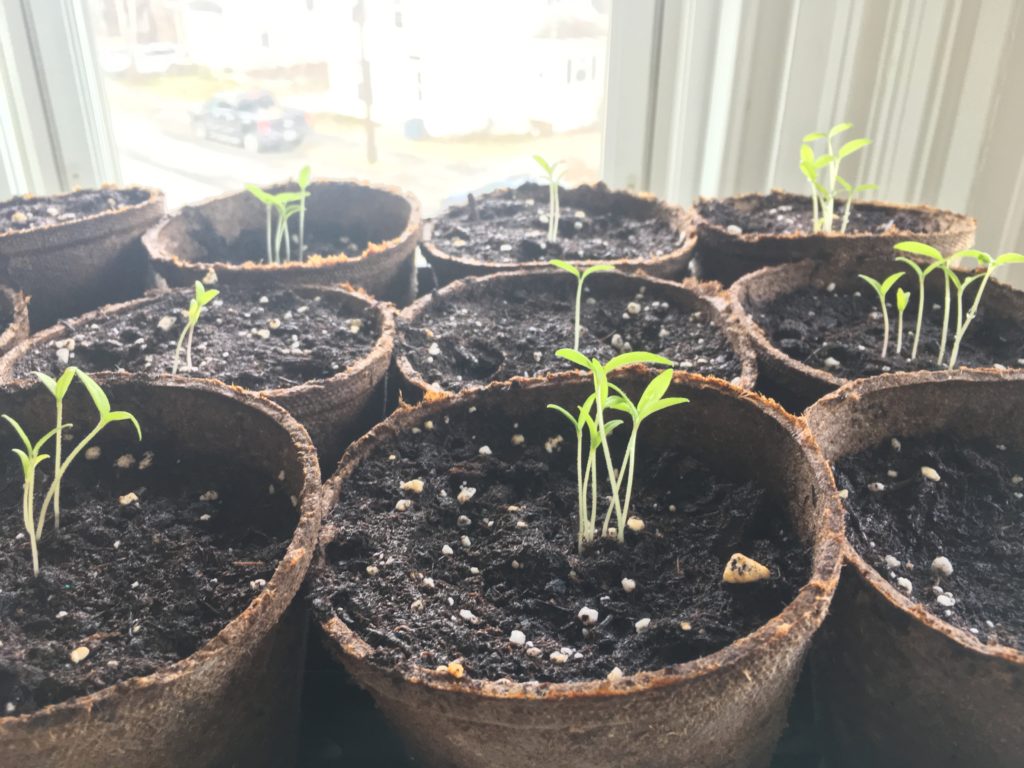How to salvage leggy seedlings

There are many advantages to starting seeds indoors including the control it gives you over the types and varieties of crops you grow. It also allows you to control the means by which the plants are produced. But growing seedlings indoors also comes with challenges like the maintenance they require.
“Seedlings are like babies,” said Jennifer Moreno, chairman of indoor gardening at the National Garden Clubs. “Everything has to be just right. You’ve got to coddle them.”
If these conditions are not met, seedlings can become “leggy,” which is a term used to describe seedlings that have long, thin and pale stalks and small leaves.
“The stem gets weak. It can’t hold itself up,” Moreno said. “They’re basically starving to death.”
Leggy seedlings are not just slightly unsightly. Legginess is often an indication that your seedlings will fail to thrive once they are transplanted.
“The other things that happens with the leggy seedlings is that they aren’t storing as much carbohydrates,” said David Graper, South Dakota master gardener coordinator. “If you’ve got a plant that wasn’t getting enough sunlight they’re not going to be able to withstand the rigors of sun and wind.”
What causes legginess in seedlings
The most common cause of legginess is an insufficient or uneven access to light. When the light source is too dim or distant, seedlings grow quickly in height to get closer to that light. As the seedling gains height, it sacrifices in girth and strength, resulting in thin, pale, fragile, stretched-out stems.
Even if seedlings are situated on a sunny, south-facing window, the average amount of sunlight in late winter to early spring generally does not meet the twelve to sixteen hours required for strong seedling development. Some windows also have coatings that can further hamper access to the sun’s rays.
“Light can be kind of a challenge indoors,” Moreno said. “They get leggy because they’re looking for the light, so a lot of times you’ll see them bending towards the light.”
Light can be especially challenging in cloudy areas or northern areas with fewer daylight hours during seed starting season.
“Legginess, or stretched seedlings, occurs basically because they’re not getting enough light exposure,” Graper said. “Cloudy weather has caused the seedlings to stretch or elongate more than they normally would.”
Overcrowding in seedling pots will also cause legginess as the seedlings compete for light.
“Crowding is related to the light conditions,” Gaper said. “If the plants are close together than the shade each other and compete for the light that is available.”
Seedlings may also grow leggy if they are not adequately watered. In a similar vein, poor soil with improper drainage can stunt growth as seedlings struggle to absorb the necessary water and nutrients.
Overheating, especially under a germination dome or on a heating mat, can also cause a burst in growth that leads to legginess. While warmer temperatures aid germination, most seedlings grow best at a high of 65 to 70 degrees Fahrenheit during the day and nighttime temperatures of 55 to 60 degrees Fahrenheit at night.
“Too much heat causes a rapid growth spurt,” Moreno said. “If you have a heat lamp on them and it’s too hot, the stems grow faster than the leaves.”
How to save leggy seedlings
The first step is to make sure your seedlings have enough light. Moreno said you can try moving your plants to a different south-facing window and regularly turning the trays to help tilting seedlings grow straighter, but artificial light is the easiest way to achieve this, especially for northern gardeners with short growing seasons.
Moreno said to make sure seedlings are only a couple inches from grow lights. Some gardeners will set up a system where the lights can be raised as the seedlings grow.
Make sure your seedlings are not clamoring for space, either. Stagger seedlings an inch or two apart once they develop the first true leaves so they have plenty of room to soak up the sun.
When it comes to addressing hydration, watering from the bottom so that roots will wick up water may also help to make sure the plants are getting sufficient hydration.
“A great way to deal with watering and be more consistent is to have a tray where you wick the moisture into the seedlings,” Moreno said. “Add a small amount of water [to the tray], allow them to sit in slightly and let them soak it up.”
The quality of your seed starting mix may also be impacting the health of your seedlings. Avoid heavy soil, like garden soil, and use potting soil or seedling starting mix that is formulated to have a loose texture with good drainage.
“You may have to look at what kind of a mix you’re using,” Moreno said. “You want something that’s going to retain the water and not dry out too fast.” Moreno recommends looking for seedling mixes with a combination of perlite, vermiculite and peat moss, or making your own. Graper and Moreno both said adding fertilizer to the soil of leggy seedlings will be ineffective.
To avoid overheating, remove the humidity domes from your seedling trays or take them off the heating mats within a couple days of them sprouting.
Hardening off the plants or transplanting them outside may also help with legginess. Most leggy plants become sturdier once they are growing outside.
You can also trigger stem strengthening through thigmotropism, a plant’s reaction to physical touch, by stimulating the movement of environmental stresses on your seedlings. Put a small fan next to your seedlings on a timer so that the plants are blown in the breeze for a couple of hours a day and gently passing your hand over the tops of seedlings a few times every day to stimulate stronger growth.
Some leggy seedlings can be saved with modified transplanting techniques. Because tomatoes have adventitious roots, which are proto-roots growing out of the stem of the plant that can grow when exposed to the right soil and moisture conditions, leggy tomato seedlings can also be salvaged by burying the stems up to the lowest set of leaves or laying the plant on its side when repotting or transplanting. This method also works for other plants with adventitious roots, like tomatillo, eggplant and pepper.

When to give up on leggy seedlings
Though it can be heartbreaking for gardeners attached to their baby plants, sometimes it is better just to cut your losses when it comes to leggy seedlings.
“If they get too skinny like that, they won’t do too well outside,” Moreno said. “Some of them are like just chuck them all and start over.”
“You can’t push it back together,” Graper laughed. “If it gets really bad, probably the best thing to do would be to plant more seeds in a sunnier location.”
Moreno said that you can often tell when seedlings are past the point of no return.
“When they get really limp and they’re kind of laying down, I just say they’re done,” Moreno said. “They look like they’re pretty much past saving, and that’s when you want to start over.”
Graper said to look out for two key things: the distance between the first set of leaves and the soil, and the distance between sets of leaves.
“The distance between the potting soil and the first true leaves should be fairly close to the soil surface, about one to two inches,” Graper said. “If it’s three or four inches, that’s probably not worth dealing with. If there’s an inch or so between each set of leaves that come out, that’s also probably going to be too leggy.”
If you have started your seedlings early enough in the season, however, you can start over with new seeds in a brighter location.
“Early in the season, there’s still time to restart some of these plants,” Graper said. “When in doubt, I would say replant.”

very helpful,Thank you! First time seeder!! Wasn’t;t easy!